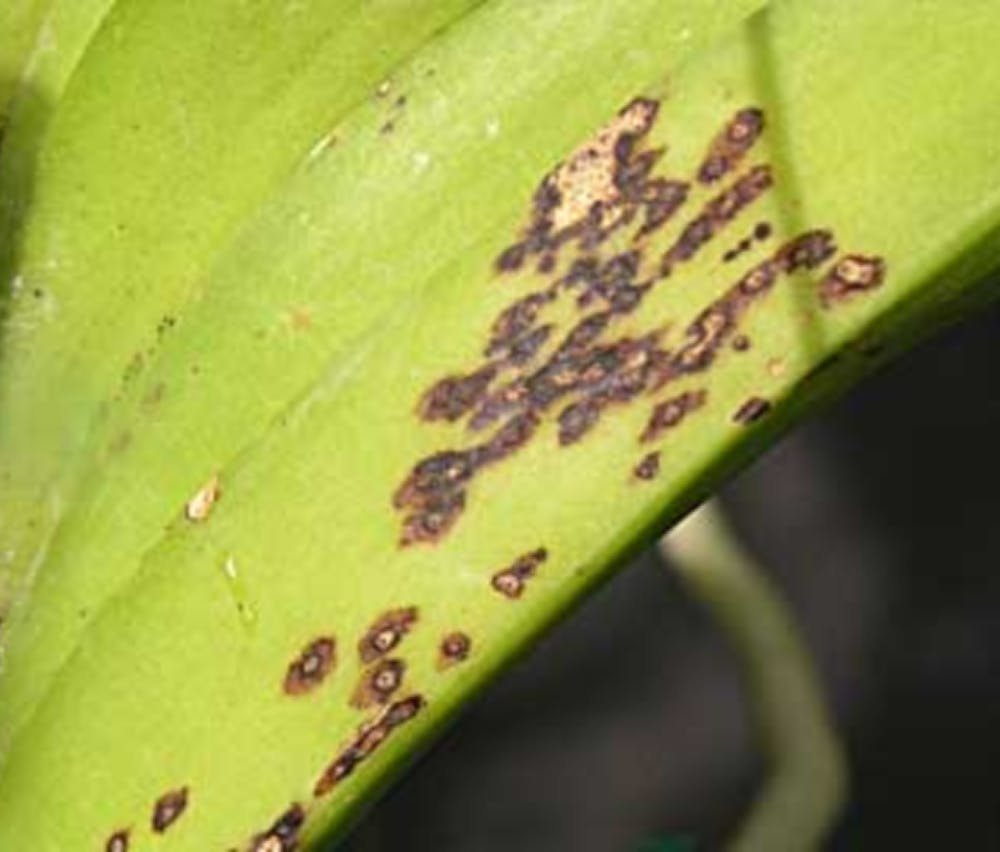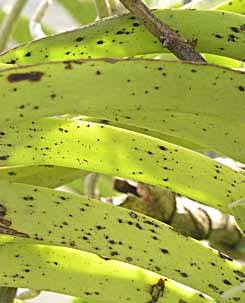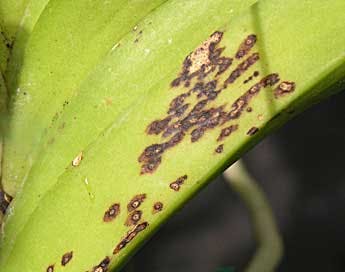
Phyllosticta Leaf Spot


Gallery


Symptoms
The first signs of a Phyllosticta infection in vandaceous orchids appear as elongated tiny purplish or black spots along the veins of the leaves. These lesions gradually grow in size, appear as long, blackish, diamond-shaped streaks, and eventually take on the characteristic eyespot appearance — the perimeter of the spot outlined in black, surrounding a tan or gray area of dead tissue, with a black fruiting body at the center. As the infection progresses, the spots can coalesce to cover the leaf. The leaf may eventually die and drop.
On dendrobiums, the fungus shows up as leaf spotting, starting as small, circular yellow spots that gradually turn black. As the fungus matures, the leaves yellow, exhibit a black weblike pattern, become more susceptible to brown rots, and may die and drop.
Symptoms of Phyllosticta’s presence take three to six weeks to appear as tiny spots on infected leaves, and several weeks longer to manifest as easily visible lesions. Higher light levels and dry conditions inhibit the growth and spread of the fungus, where in lower-light growing areas where as there is plenty of humidity, or during a series of rainy, overcast days, Phyllosticta has a greater opportunity to gain a foothold.
Treatment
Remove and dispose of affected leaves from infected plants to keep the fungal spores from spreading into the growing environment. Some growers have reported covering the mature lesions with clear nail polish to prevent the dissemination of spores.
Repeated applications of fungicides such as Dithane M45, Captan, Ferbam, Mancozeb or thiophanate-methylbased treatments will help control infection levels and can prevent new infections in healthy plants, but it is difficult if not impossible to completely eradicate the fungus in an infected host plant. As always, when using any sort of chemical control on your orchids, strictly follow the manufacturer’s instructions for dosage and safety.
Prevention
Isolate new plants for a period of a month to two months if possible before introducing them to the rest of your collection. This should allow enough time for any pest or disease to present itself and be dealt with, rather than allowing them to spread to healthy plants. Segregate any infected plants from those that are healthy; this fungus is highly contagious and easily spread. Watering practices should allow for the plant to dry before nightfall, to keep the environment less hospitable to fungi and bacteria that thrive in moist, dark and cooler conditions. Keep the growing environment clean. Remove all dead plant material and allow for adequate air circulation between and around plants.
Additional Information
By Susan Jones
Further Reading
Simone, Gary, PhD, and Harry C. Burnett, PhD. 2002. “Diseases Caused by Bacteria and Fungi.” In Orchid Pests and Diseases. American Orchid Society, Delray Beach.
Uchida, Janice Y. “Phyllosticta capitalensis.” Crop Knowledge Master, Department of Plant Pathology, University of Hawaii.
Susan Jones was the editor of Awards Quarterly and assistant editor of Orchids. American Orchid Society, 16700 AOS Lane, Delray Beach, Florida 33446
All reuse must contain the following:
Reprinted from the SEPTEMBER 2003 issue of Orchids -- The Bulletin of the American Orchid Society. Copyright American Orchid Society -- www.aos.org
Host Orchids
Although it is most often seen on dendrobiums and the Vanda Alliance, the fungus also infects Brassolaelio cattleya, Cattleya, Cymbidium, Epidendrum, Laelia, Laeliocattleya, Odontoglossum. Oncidium, Phalaenopsis and a broad range of other orchids.
Life Cycle
Two types of spores of this fungus germinate when moisture is present: conidia and ascospores. Conidia can quickly be carried from diseased plants to healthy ones by splashing rainwater, sprinklers or watering. In addition, the ascospores are discharged into the air and can travel between plants on a breeze or current. If they land on a moist leaf, ascospores germinate, infect the orchid host, and begin the cycle anew.
Although Phyllosticta does not kill an orchid, it may weaken the plant to the point where it easily falls prey to other pests or diseases.

FREE ACCESS: Orchid DealWire
Get notified when orchid vendors have special promotions and exclusive savings.







